In this episode of NewsChakra, senior journalist Abhisar Sharma talks about the children who have lost their lives to Acute Encephalitis (AES) in Bihar
Courtesy: News Click
Courtesy: News Click
Lawyers Collective (LC) an organisation that has been at the forefront of several key human rights cases in India, is now in the crosshairs of a vindictive regime. On June 18, the Central Bureau of Investigation booked LC and its founding member Anand Grover for alleged violation of the Foreign Contribution Regulation Act (FCRA) 2010. However, now LC has released a statement setting the record straight.

Picture courtesy BCCL
Expressing “shock and outrage” LC says they are being victimised by the State for taking on sensitive cases where the key accused are people who occupy high offices in the present government. The statement says, “In the immediate past, the office bearers of the LC have represented the persons detained in the Bhima Koregaon case, the Police Commissioner of West Bengal, Rajiv Kumar and while not commenting on the merits of the case, have been vocal on the subversion of due process of law in the Courts in the matter of the alleged sexual harassment by a former employees of the Supreme Court of India.” Indira Jaising, a founding member of LC was has also been at the forefront of several key human rights cases. Recently, Jaising was very vocal about the manner in which the SC dealt with allegations of sexual harassment against Chief Justice Ranjan Gogoi. It is also noteworthy that LC founding member Anand Grover was a part of a team of lawyers that petitioned the SC on behalf of 1993 blast convict Yakub Memon to postpone his execution, just hours before he was hanged.
The statement says, “The LC has reason to believe that its officer bearers are personally being targeted for speaking up in defence of human rights, secularism and independence of the judiciary in all fora more particularly in their capacity as senior lawyers in court. The LC sees this as a blatant attack of the right to representation of all persons, particularly the marginalised and those who dissent in their views form the ruling party. It is also an attack in the right to free speech and expression and an attack on the legal profession as such.”
It is alleged that the CBI acted against LC, its functionaries as well as certain private individuals after receiving a complaint from Anil Kumar Dhasmana who is the Under Secretary in the Union Ministry of Home Affairs (MHA). This complaint states that after inspection of the books of accounts and the records of the NGO, a prima facie violation of the FCRA 2010 was noticed. The complaint was made on May 15 shortly after a petition was filed in the SC by a group called Lawyers Voice making similar allegations.
On June 13, the CBI had filed an FIR against LC, Anand Grover and others for suspected offences of criminal conspiracy, criminal breach of trust, cheating, making of false statement in the declaration under the FCRA 2010, and criminal misconduct under the Prevention of Corruption Act, 1988. In addition to invoking the provisions of the Indian Penal Code, the CBI has charged them under Sections 33, 35, 37, and 39 of the FCRA 2010 and Section 13(2) with Section 13(1)(d) of the PC Act.
Pointing out the antecedents of Lawyers Voice, the statement said, “The Lawyers Voice comprises lawyers from the BJP and its main protagonist is Mr. Neeraj is the head of the Legal Cell of the BJP in Delhi. The organization clams it has no income and no PAN card, a mandatory requirement for filing a PIL. When the Petition was filed the LC pointed out in a press statement that the petition did not have the basic averments of a writ petition under Article 32 of the Constitution, and therefore was not maintainable. We have expressed our surprise that notice on the Petition was issued at all in the said Petition.”
This FCRA matter originally dates back to 2016, when the MHA had cancelled the FCRA license of the organisation. LC had challenged this in the Bombay High Court and the appeal is still pending before the court. According to LC’s statement, at the time of filing the appeal, LC had pointed out “that the FCRA proceedings were taken against it because its office bearers had taken up sensitive cases against the leading figures of the BJP and the Government of India, including Mr. Amit Shah, the present Home Minister, in the Sorabbudin case, amongst others.”
The MHA had also raised objections to Jaising continuing to receive remuneration from LC when she was serving as Additional Solicitor General of India. But LC had clarified, “Ms. Jaising’s remuneration was permissible under the FCRA, it was being paid by the LC was before she became the ASG and continued during and after her tenure in that capacity. Moreover she taken the permission of the Law Minister to continue to receive the remuneration under the Law Officers (Terms and Conditions) Rules, which has been admitted by the MHA. The allegation of the MHA was premised on the assumption that as the ASG Ms. Jaising was a government servant, which she was not.”
The complete statement by LC may be read here:

Right To Information (RTI) activist, Nanjibhai Sondarva (35) was allegedly clubbed to death by six persons in March, 2018.
His only crime being that he had filed an RTI application demanding transparency about funds spent on the construction of a road in his village. Just an year before his murder, his family was allegedly assaulted by the village sarpanch who was said to be furious at Nanjibhai for using RTI to expose financial irregularities in the developmental works undertaken in the village.
National Commission for Human Rights (NHRC) has recently registered a complaint filed by Venkatesh Nayak, RTI research scholar and coordinator of Commonwealth Human Rights Initiative (CHRI) pressing for a thorough inquiry into the murder of Rajesh Sondharva
Nayak noted, “Although Rajesh was not an RTI activist himself, this is the 14th instance of murder in Gujarat with an RTI connection. Since October 2005, media reports have linked at least 13 murders to citizens’ RTI interventions aimed at exposing corruption and wrong doing in the administration- the second highest after Maharashtra (17 alleged murders, so far). The country-wide tally now stands at 83 reported cases of alleged murder and at least 165 cases of assault, 180 cases of harassment or threats- all targeting RTI users and activists. At least six cases of death by suicide have also been linked to RTI-activism of the victims.” CHRI maintains The Hall of Shame where they map and document instances of attacks on RTI users.
As Nanjibhai’s case was admitted in the trial court, the local police didn’t do enough to monitor it. This included an absence of reporting on the violation of bail conditions by the accused. Rajesh was trying to highlight the violation of bail conditions by the accused.
In the note that Nayak shared with human rights groups, he expressed concern if the Whistleblowers Act ever see the light if the day.
Parliament enacted the Whistleblowers Protection Act (WBP Act) more than five years ago, in February 2014. The Act has not seen the light of day. Instead the Government pushed through the 16th Lok Sabha, a series of retrograde amendments that would have effectively discouraged any potential whistleblower from exposing corruption and wrong doing. The proposed amendments barred inquiry into complaints if they were covered by any of the exemptions listed in Section 8(1) of The Right to Information Act, 2005 – imported lock stock and barrel into the WBP Act.
The Bill has lapsed with the constitution of the 17th Lok Sabha.
The note highlighted that the Rajkot police has refused to publicise a copy of the FIR relating to the alleged murder of Rajesh Sondharva. Uploading FIRs on the Police’s websites is a mandatory requirement as per the directions of the Hon’ble Supreme Court of India in the matter of Youth Bar Association of India vs Union of India & Ors.,[Writ Petition (Crl.) No. 68 of 2016, order dated 07 September, 2016].
The Rajkot Police has refused to put a copy of this FIR on the website claiming that it is a sensitive matter. In the Youth Bar Asson. case the Hon’ble Supreme Court made an exception to the rule of proactive disclosure only for FIRs relating to sexual offences, offences under POCSO Act or those relating to terrorism or insurgency. The murder case of Rajesh Sondharva does not fit into any of these categories.
In the jungles of Sundarban, the Royal Bengal Tiger is prayed to and revered as Dakhin Ray, the God who must not be named. For everyone who ventures into the forest, to fish in its waters or for wood or honey, the only deity who saves them from Dakhin Ray is Bonbibi or the Goddess of the Forest. Bonbibi is a deity who is revered by people cutting across religious lines – it’s obviously Islamic iconography is not an impediment for her Hindu devotees, nor do her Muslim followers see any contradiction in praying to her statue present in omnipresent makeshift temples that barely rise above the tides. But now, with the rise of the BJP in West Bengal, Bonbibi is a tool of communal politics with some denying her origins in the sufi ‘pir’ movements of Bengal, her presence as an example of syncretism, even questioning her name itself. They want her to be called ‘Bondevi’.
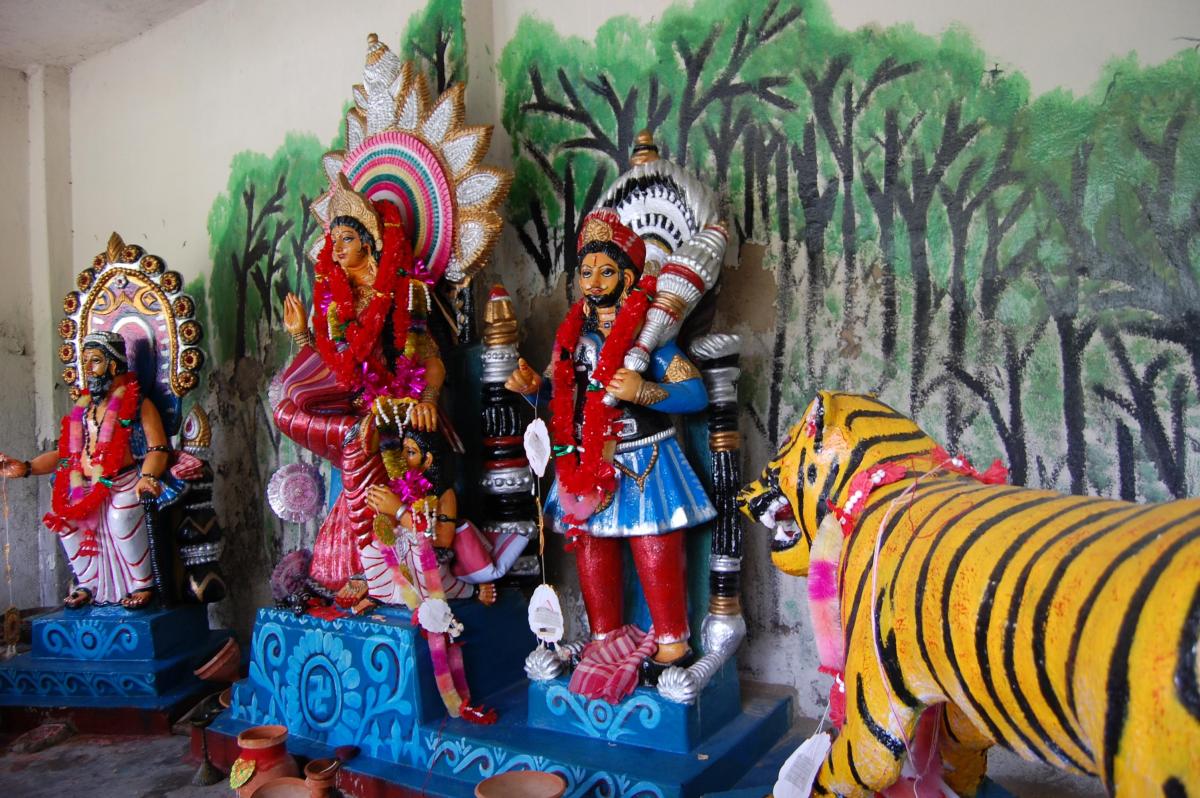
Who is Bonbibi?
Bonbibi, meaning mother of the forest, is said to be the goddess of the Sundarbans, a mangrove area spanning from the Hooghly River in West Bengal to the Baleswar River in Bangladesh.
According to the local belief, found in the eighteenth century text ‘Bonbibir Johuranama’, Bonbibi was the daughter of Ibrahim, a fakir who came from Mecca and became the king of the Sundarbans. He had no children from his first wife, Phoolbibi. He married Golabibi who gave birth to twins Bonbibi and Shah Junglee, but Ibrahim had promised his first wife he would abandon the second. When Golabibi was pregnant, he left her in the woods. This is where Bonbibi was born and raised as a Muslim since birth.
In the jungle, the brother sister duo fought a fierce battle with the evil lord Dakkhin Ray who takes the form of the tiger and his mother Narayani and win.
Since then, the legend goes, honey collectors and woodcutters before entering the Sundarbans, worship Bonbibi and pray for their protection from attacks.
In the Sundarbans, where death can come quickly, its inhabitants have worshipped Bonbibi for centuries as a protection from the jungle’s many dangers.
BJP-led communalization:
At several places in the Sunderbans during the election, BJP leaders began their campaign with the worship of Bonbibi in the name of Bondebi, solemnised by some local priests, and made public statements about the local tradition of which the deity is an integral part.
BJP leader and local panchayat member Paritosh Mandal of the Sundarbans says, “Muslims never worshipped Bonbibi. This tradition has been kept alive by the Hindus and it’s they who have been worshipping the goddess. That’s why we address her as Bondebi instead of Bonbibi. Now the villagers call them by this name.”
The local BJP leaders are using their power to influence the locals as well.
What do the locals say?
A honey collector from Gosaba, Sudapa Monday, says “We regularly take the idols of the goddess with us and worship her at the riverside before entering the forest. But the Muslims don’t worship her any longer.”
Contrarily, a Muslim local said, “Calling Bonbibi Bondebi defies our joint heritage,” adding that not only the Hindus but Muslims also have faith in Bonbibi. Another Muslim local, Aminur Shana, a honey collector says, “I enter the forest in the name of Allah and I feel safe.” And then he added, “But occasionally when I sense any danger of tigers or snakes, I ask Maa Bonbibi for protection.” Seeking refuge from Bonbibi gives him courage. “You are my mother. As your son, protect me from the tigers and other dangers of the forest,” Shana would say in his mind when he feels vulnerable.
However, the Muslims are hurt by this “propaganda” and so they have distanced themselves from the centuries-old tradition. Auto-driver Arafat Sheikh and his wife Nazma Sheik says, “Idol worship was never present in our religion. Our ancestors used to worship our deity because they went into the jungle, but we don’t look at the forest for a profession anymore. We attend the fairs during the Bonbibi Puja, but don’t visit the temple.”
But there are many, who still depend on the forest for survival and for whom the fear of the tiger is beyond religion. For them, Bonbibi is neither Hindu nor Muslim. She is the mother who protects them .
A communal ploy to kill a tradition
Particularly strange is the fact that only a few miles away, across a watery border lies Bangladesh. It houses over sixty percent of the mangrove forests of Sundarban and most of its elusive man-eating tigers. In the absence of the BJP, its reigning deity remains Bonbibi and not Bondevi.
However for the BJP, the only road to power is the one that rides roughshod over many homegrown, local, traditions and rituals. Implicit in its planned, relentless propaganda at demonising the Muslims of India is the denying of all cultural capital that is either syncretic, secular or Islamic. To the outsider, Bonbibi and Bondevi may be interchangeable. To the pracharaks on the ground, the difference is ideological, absolute and necessary. For the Muslims of Sundarban, it will represent an enforced loss of identity – one that will push them closer to homogeneity and who knows, perhaps fundamentalism. For India however, it will be yet another loss of memory. Memory of a kind that once made it ‘saare jahan se acha’.
“Torture means any act by which severe pain or suffering, whether physical or mental, is intentionally inflicted on a person for such purposes as obtaining from him information or a confession, punishing him for an act he has committed or is suspected of having committed.”
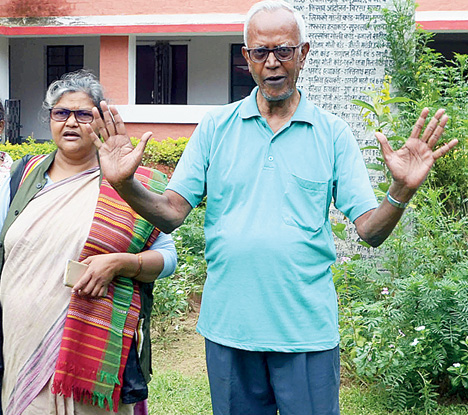
A couple of years ago, India’s Attorney General had said at the UN that “Ours (India) is a land of Gandhi and Buddha. We believe in peace, non-violence and upholding human dignity. As such, the concept of torture is completely alien to our culture and it has no place in the governance of the nation.” (Baljeet Kaur in EPW Vol. 53, Issue No. 36, 08 Sep, 2018)
Fine words indeed. However the 2015-2016 NHRC Annual Report states:Custodial violence and torture continue to be rampant in the country. It represents the worst form of excesses by public servants entrusted with the duty of law enforcement.
Between September 2017 and June 2018 news reports noted 122 incidents of custodial torture resulting in 30 deaths. There has been no consistent documentation of torture-related complaints. The National Crime Records Bureau (NCRB) does not document cases of custodial torture.(Baljeet…)
Let us enumerate some of the tortures taking place in the context of Indian government’s efforts to do away with so-called ‘extremism’ in the country:
Now let us ask ‘who’ and ‘what’ are theseindividuals. They are perhaps the most precious human beings who have given the most and best of themselves for the cause of truth and justiceand have clearly taken the side of the deprived, marginalized sections of society. They have expended their individual charisma, professional expertise, unconditional solidarity with the deprived masses and many of them have achieved phenomenal success in bringing relief to the abandoned lot of human beings about whom the rest of society does not bother. They have deprived themselves of social & economic security which they otherwise would have enjoyed.
When the ruling class instead of commending their commitment is bent upon punishing them in meanest ways, it is deplorable.
Is this not torture ?
A vexing question is how did they come to be arrested as ‘naxals’ / ‘sympathisers of naxals’? The above-mentioned study found out that about 57% were arrested while they were at their homes.30% were arrested while travelling, at railway station or at a town while shopping. Eight percent said they surrendered themselves on being informed that there was a case registered against them, and five percent said that they were summoned by the police to the station ostensibly for some other purpose but on arrival they were arrested. However, most of the charge sheets filed by the police state that these arrests were made from forests. This mismatch is a clear indication that the police habitually fabricate cases against Adivasi villagers. (from above-mentioned study, p.56)
It is important to remember that greater part of them are young people. 22% are in the age-group of 18-28 which is the most creative part of one’s life and 46% are aged 29-40 which is the most productive part of one’s life. (facts from above study, p.50)But the repercussions of their imprisonment on themselves and their families are tragic. Many families have mortgaged or sold off the little assets such as their land, cattle. The sole breadwinner of the family is either in jail or implicated in cases. It is heart-rending to see many families have been reduced to destitution and their small children are growing up without paternal love and care. And knowing full well that if and when they are tried most of them will be acquitted.Hence their trial is deliberately prolonged no end.Is this not torture ?
It is common knowledge that prisoners are systematically tortured in our country. The poorer you are, the more liable you become a victim of physical torture in prison. Even very educated, knowledgeable, professionals are not exempt from physical as well as mental torture. It became evident when one of the accused in Bhima-Koregaoncase who is himself a lawyer was repeatedly slapped during police custody in Pune jail to the extent he had to be taken to the hospital. If this can happen to an eminent legal professional,the fate of poor helpless under-trial prisoners is best left to one’s imagination.
Is this not torture ?
And yet we are told ‘India is the land of Buddha and Gandhi and torture is just not part of our culture’ !
We can only take solace from the endearing song of our revered patriot, philosopher, poet Rabindranath Tagore. . .
Where The Mind Is Without Fear
Where the mind is without fear and the head is held high
Where knowledge is free
Where the world has not been broken up into fragments
By narrow domestic walls
Where words come out from the depth of truth
Where tireless striving stretches its arms towards perfection
Where the clear stream of reason has not lost its way
Into the dreary desert sand of dead habit
Where the mind is led forward by thee
Into ever-widening thought and action
Into that heaven of freedom, my Father, let my country awake.
Related Articles:
4,000 Adivasis, Charged as ‘Naxals in Jails of Jharkand
Fence Eating the Crop ! NHRC Finds Fake ‘Naxalite-Surrenders’ in Jharkhand
Wardha: In another dreadful incident of cased-based discrimination and atrocity, an 8-year Dalit boy named Aryan Khadse was made to sit on hot tiles over the suspicion of theft from a temple in Arvi in Wardha.

As reported in the ANI, Khadse suffered severe burn injuries after he was allegedly made to take off his clothes and sit on the tiles which were simmering due to the scorching heat. The incident took place on Saturday after the accused, Amol Dhore (32), suspected that Khadse had stolen coins from Jogona Mata temple, a local temple, while playing in its premises.
“I went to drink water. They were drunk. They tied my hands and legs and beat me up and then made me sit on the hot floor. I then somehow managed to run away,” the 8-year-old victim said while narrating his ordeal.
“When I saw my child, his derriere was burned and we took him to the hospital immediately. When we enquired about the incident, the accused started verbally abusing us,” the child’s mother said.
Aryan’s father, Gajanan Khadse, approached the police and lodged a complaint against Dhore at the Arvi police station. According to Pradeep Maral, Sub-Divisional Police Officer (SDPO), “An accused has been arrested and a case has been registered under the Scheduled Caste and Scheduled Tribe (Prevention of Atrocities) Act-1989.”
It is also pertinent to note that the PSI and investigation officer, Parmeshwar Agase, said “There is a doubt whether the accused punished the victim for simply entering the temple. Usually, all children of this area play in the temple everyday and nobody has any objections. We have arrested the accused and investigation is underway.”
Women and Child Welfare Minister Pankaja Munde said that the state government has taken serious note of the incident and has instructed officials to take the strictest possible action. “Such incidents bring out reality in society. We, as the government, have taken action but it’s also the responsibility of the society to introspect,” she said.
The Child Rights Commission is also expected to visit the place and provide counselling to the victim.
This deplorable incident has once again brought to the fore the miserable cases of caste discrimination prevalent in India even today.
Related Articles:
India has become the largest market for Facebook with almost 300 million active users. It is also pertinent to note that Facebook India has an unprecedented growth potential of over 400%, thereby making India the future of Facebook. While Facebook’s gargantuan influence is unstoppable and being a platform for the otherwise voiceless undeniable, the cause of concern is the increasing use of the social media giant as a central avenue for hate mongering and violence.
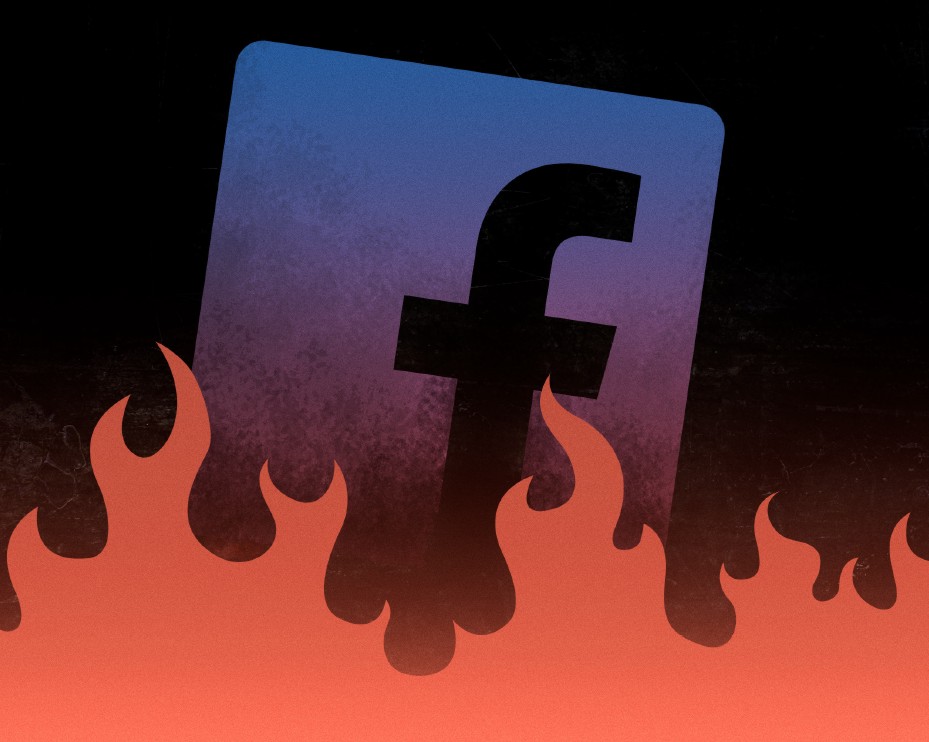
Equality Labs, a South Asian American human rights and technology start-up, has provided evidence and raised alarm on Facebook India’s lackadaisical response to violations of its community standards in its report “Facebook India: Towards the tipping point in violence, caste and religious hate speech.” It has also thrown light on the role of Facebook India as a soapbox for hate mongering, communal violence, fake news among other things. The report also recommends an independent human rights audit of its content and proactive steps to curb the online hate speech that can quickly erupt into severe violence. The report reveals some really perturbing trends relating to huge volumes of direct hate speech, disinformation and calls to violence against Indian caste, religious and gender/queer minorities as well as the freepress.
Key findings:
As per the report, 37% of the hate speech is about Islamophobia followed by fake news (16%) and the least is about anti-religious minorities (9%). The following graph gives a glimpse about the composition of hate speech on Facebook India from 2014 to 2019.
The massacre of Muslims in the Ayodhya incident is a black day in India’s history. While the bitter memories continue to haunt us, Facebook India has become a platform for instigating violence through posts of anti-Muslim attacks in Ayodhya.
Out of the 37% Islamophobic hate speech, 10% is about anti-Muslim attack in Ayodhya, 6% content is on anti-Rohingyas, calling for violence against them and is similar to the content that led to the Rohingya genocide in Myanmar. Also, 5% hate speech is related to ‘Love Jihad.’
13% of the hate speech on Facebook India is related to casteism. Notably, 40% of such posts are against affirmative action in India i.e. Reservations for the minorities.
Despite the Supreme Court decriminalizing section 377 in 2018, it seems that the masses have not yet accepted the verdict and it is a long journey before the sexual minorities receive social acceptance. Of the 13% gender/sexuality hate speech, 25% is related to transphobia/queerphobia. Further, 12% of the hate speech posts under this category calls for violence or glorifies or trivializes rape.
Under the category of hate speech against religious minorities, which forms 9% of the total hate speech, 60% are anti-Christian posts while 25% are anti-Buddhists.
In this era of fake news where social media is constantly being used to mislead the masses, Facebook India contributes 16% of such false news. Strikingly, 50% of this is misinformation about current events. Further, while there have been repeated attempts by the state as well as the central government to change the Indian history and glorify one particular religion, 20% of the fake news on Facebook India is about false South Asian history.
While Facebook claims that it responds within 24 hours of receiving a complaint related to hate speech, the Equality Labs report has found the median time of response by Facebook India to be 48 hours.
While the response time by Facebook India on the complaints is slow, what is more disturbing is that 93% of all hate speech posts reported to Facebook remain on Facebook.
Further, 43% of all initially removed posts were found to have been restored after an average period of 90 days from the date of reporting. Alarmingly, 100% of all restored posts were Islamophobic posts.
While hate speech almost completely remains or is reinstated by moderators on Facebook, an increasing number of minority user accounts are being banned or removed entirely.
Caravan Daily wrote that in a ten day period, Facebook disabled personal accounts of more than a dozen leading journalists in India without any warning or notice and without offering any credible reasons. This includes editors of BoltaHindustan.com, Mumtaz Alam, Editor of Caravan Daily, Syed Ghazanfar Abbas, National Correspondent of Caravan Daily. Ajay Prakash (News Editor, Dainik Bhaskar), Prerna Negi (Editor, Janjwar.com), Rifat Jawaid (Editor, JanataKaRepoter.com and former Editor of BBC) and Aijaz Zaka Syed, an award-winning Indian journalist and columnist based in the Gulf and former Opinion editor, Khaleej Times. Syed has also been associated with Caravan Daily as a columnist.
Also, accounts of prominent Dalit Bahujan news outlets and pages like National Dastak and Ambedkar’s Caravan, those of Kashmiri activists and press outlets like Freepress Kashmir were taken down.
While Facebook India has performed very poorly when it comes to taking action against hate speech and hate mongers and seems to increasingly become a platform for communal polarisation, one major loophole in its reporting mechanism is the unavailability of its community standards in major Indian languages. This makes it very difficult for the minorities to report the oppression that they face on Facebook. Also, the report reveals that there is no consistent reporting mechanism.
Conclusion:
All in all, it appears that Facebook India has become a political tool for spreading one particular ideology and resorting to hate mongering for wiping out the minorities and further other them. It has become like a toothless watchdog allowing gross violations of its own community standards thereby creating a breeding ground for violence and revenge. To give a reference, popular right-wing Hindutva activists like Harsh Chikkara, Deepak Sharma, etc have used Facebook to instigate the public, like in the recent Aligarh rape case where the accused are Muslims. CJP has been constantly fighting and monitoring hate on Facebook. Last year, CJP approached the NHRC and Facebook to report the hateful content posted by Hindutva activist Deepak Sharma that got his account banned.
Whether this insouciant behaviour is a path that is chosen by Facebook India or is the result of political pressure is yet unknown. However, this is having a widespread impact on the harmony and peace, nationally as well as internationally.
The Equality Labs report rightly says, “The situation is grave enough that we must see an overhaul of these processes—nothing less than the integrity of India, the world’s largest democracy, is at stake.”
The entire report can be read here.
Related Articles:
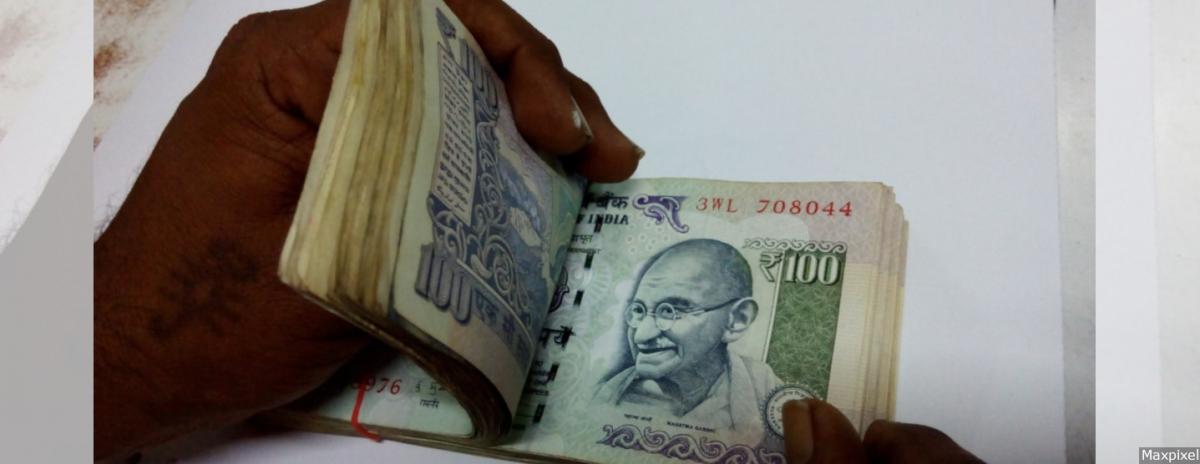
Despite efforts to propel adoption of digital payments, such as the creation of India Stack, which uses Aadhaar to make transactions cheaper and efficient, and a government-supported unified payment interface (UPI), the “the cash-to-GDP ratio was already back to pre-demonetisation levels by May 2018,” the March 2019 study noted.
Conducted by the University of California, the study focused on digital adoption by small-scale fixed store merchants in Jaipur, Rajasthan. It surveyed 1,003 fixed store merchants (“businesses conducting enterprise activities outside the household but within permanent structures”) in August-September 2017, following a census listing that identified 6,011 households and enterprises in Jaipur. It did not include street vendors, home-based business, and service providers.
Catalyst, an initiative funded by United States Agency for International Development under the mSTAR or Mobile Solutions Technical Assistance and Research programme to increase adoption of digital payments in India, collected the data.
Advocates of digital payments say they provide more security than cash, ensure transparency by making transactions traceable and hence taxable, and improve financial inclusion by spreading access to financial services, including savings accounts, especially among women. It was claimed as a key objective of the November 2016 demonetisation, as we explain below.
Although critics point out that a hasty move towards digitalisation can leave behind the already disadvantaged who are not digitally literate, policy-makers seem to concur on the benefits of digital payments for economic growth, and the RBI aims to increase the annual per capita digital transaction 10 times to 220 by March 2021.
The total volume of digital transactions increased 58.8% to 23.4 billion digital transactions between 2017-18 and 2018-19, noted a June 11, 2019, RBI report. Payment and settlement systems are at the “heart of a modern economy” and provide the infrastructure for channelising savings and investments for the entire economy, it added.
Merchants meet prerequisites, but reluctant
Of the 1,003 respondents, 582 said the top three reasons for not adopting digital payments were lack of customer demand (54.7%), lack of awareness (41.7%) and a fear of being cheated (41.7%).
The reasons for adoption, as per 421 respondents, were demonetisation (73.8%), customer demand (62.9%), and ease of use (37.2%).
Both adopters and non-adopters stated customer demand as a top reason. “This suggests that adopters may have (or at least believe they have) more customers who demand to pay digitally than non-adopters,” the study noted.
“Supply-side barriers” such as the costs of digital payment systems and related infrastructure were not listed as reasons for low adoption. Nearly 98.6% of respondents were found to be “feasible prospective digital payment users, in that they have the necessary documents, business income, and literacy so that they could satisfy all of the prerequisites for digital payment adoption if they so chose,” the study noted.
Nearly 54.2% of the sample merchants satisfied all requirements: 97% of merchants had a bank account, 79% had an internet-accessing device, 55% had internet access, just under 100% could afford the related usage fees, and 96% were technologically literate. Yet only 42% had adopted digital payments.
Among current digital payment users, “usage is low, with around 80% of their transactions with customers still being done in cash,” the report added.
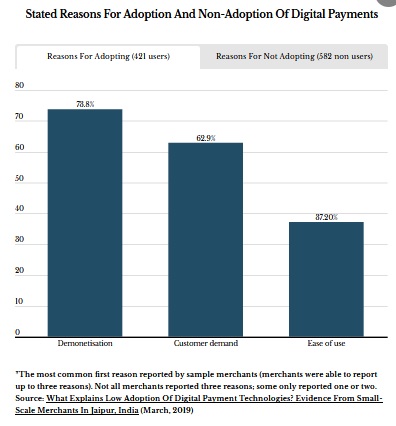
Low adoption “may depend mainly on other demand-side factors” such as the price of adoption (the charges that apply), the study noted. Beliefs about customer demand to pay digitally, and increased tax liabilities associated with digital payments, also seem to play an important role in merchants’ decisions to adopt digital payments, the study added.
“There are huge differences in adoption across countries,” Ethan Ligon, associate professor at the University of California and a co-author of the study, told IndiaSpend. “In the US and Europe the dominant payment system is credit or debit cards which has already squeezed out cash for most retail transactions save for small-value in-person transactions.” This can be seen in the US where cash accounts for less than 10% of transactions by value, and in major cities it is now common for retailers not to accept cash at all.
In India, penetration of credit or debit cards remains fairly low, but the dangers of carrying cash are much lower than in some other low-income countries, he added. This means mobile money is not competing against credit or debit cards, as in the US or Europe. It is competing with cash.
Digital transactions in India have seen a near tenfold increase to 22 transactions per capita from 2013 to 2019, but remain fewer than in other BRICS countries: China (97), Brazil (149), Russia (179), South Africa (79), a May 2019 Reserve Bank of India (RBI) report said.
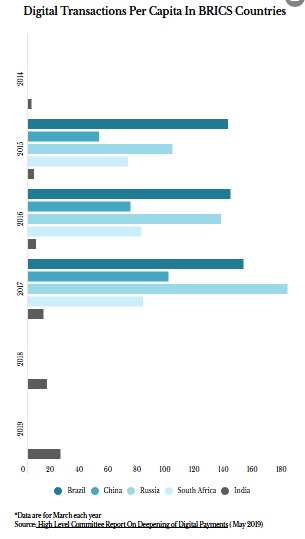
With the right measures, per capita transactions could grow by a factor of 10 in three years and reach 220 by March 2021, said the RBI report, which was penned by its Committee on Deepening of Digital Payments, led by Nandan Nilekani, the architect of the Unique Identity Authority of India (UIDAI, or Aadhaar).
Digital payments are more widespread in sub-Saharan Africa, with 97% of adults in Kenya making a digital payment in 2017 and 60% in South Africa, compared to 29% in India, IndiaSpend had reported on May 17, 2018. Up to 80% of Indians had a bank account, the same proportion that had a mobile phone, but financial inclusion levels were still among the world’s worst, we reported.
India’s density of ATMs per geographical area (69 ATMs per 1,000 sq km) is second only to China (100 ATMs) among the major emerging markets, but it is still not enough given India’s higher population density, Livemint reported on October 23, 2018.
Demonetisation impetus not enough
In November 2016, the government had announced demonetisation (withdrawal of high-value currency notes, amounting to 86% of currency by value). Its objectives were “quite substantially” met, economic affairs secretary Subhash Chandra Garg was reported to have said in the Economic Times on August 29, 2018.
The stated objectives, which changed over the following days, included promoting digital transactions, and checking black money, terror financing, and circulation of fake currency notes. More than 99% of the withdrawn Rs 500 and Rs 1,000 currency notes were returned, while Rs 11,000 crore were not.
Merchants in Jaipur reported an increase in the percentage of customers demanding to pay digitally after demonetisation, “followed by a decrease in demand in the subsequent period (though not all the way to pre-demonetisation levels),” said the study.
“The demonetisation temporarily reduced consumers’ ability to use cash, and had India not remonetised (albeit with some hiccups), I’m confident that digital payment adoption would have been given a big boost,” Ethan Ligon, co-author of the study, told IndiaSpend. “The catch is that without remonetisation the government would also have been dealing a serious blow to the economy.”
A comparison between adopters and non-adopters shows that “before demonetisation, 6.65% of customers of the adopters and 2.88% of customers of the non-adopters demanded to pay digitally. Directly after demonetisation these percentages were 26.09% and 12.36%, and at the time of the survey they were 15.10% and 5.22%.”
“It is possible that post-demonetisation there was a surge in the use of digital payments because of the lack of cash, and that once cash supply was restored, people only use digital payments as a fallback option,” Reetika Khera, a development economist, told IndiaSpend. “Contrary to the rhetoric, there is a debate about [to] what extent we should be celebrating digital payments.”
Payment fraud enabled by digital payment systems has been reported in India, and the abstinence from digital payments could be attributed to “people’s raw wisdom”, she added.
“Bank accounts simply aren’t that important to people who prefer to use cash in transactions, and who store wealth in physical assets such as land, grain, or gold,” Ligon said. “A preference for cash and physical assets makes sense if one doesn’t trust the financial sector, or the government, which plays such a large role in regulating it, as in India.”
Basic literacy, and access to and ease of using the modern banking system, have a bearing on why digital payments are low, and India’s priority should be to ensure that people have easy access to a robust, reliable and friendly banking system, Khera added.
Goods and Services Tax (GST) an incentive?
Digital payments tend to “promote business transparency, as they aid in creating an official transaction record for enterprises”, the study noted. Nearly 74% of those who adopted digital payment methods said they had registered for the Goods and Services Tax (GST), while only 48% of non-adopters said they had.
Out of the subset of businesses who report they are mandated to register for GST,
78.4% were adopters and 60.63% non-adopters. This showed that “digital payment users are significantly more likely to report that they are already registered to pay GST,” the study added.
Ligon is skeptical about the influence of tradition in people’s reluctance in moving from cash to digital payment methods. The key difference “is that transactions involving cash are anonymous, and so less transparent,” said Ligon. “People who value this anonymity and lack of transparency will always have a reason to prefer cash.”
However, the top takeaway from the research is that digital payment adoption depends on the incentives provided by the tax system, not the characteristics or costs of the digital payment platform itself, added Ligon.
“When new technologies are introduced, the existing ones should be phased out slowly based on a careful, independent evaluation of whether new technological interventions are achieving the desired effect. However, that has not happened,” Narayanan of Azim Premji University said.
People have been forced to migrate to new platforms without seeking their consent. For instance, the mapping of rural bank accounts with the Aadhaar Payment Bridge System was done without the consent of the pensioners or MGNREGS (rural jobs programme) workers concerned. Workers’ money was reportedly diverted to Airtel wallets and ICICI bank accounts, he said, adding, “Such experiences serve only to increase the misgivings of people.”
(Paliath is an analyst with IndiaSpend.)
Courtesy: India Spend
Join our mailing list to get the latest human rights news that matters, straight to your mailbox.
Join our mailing list to get the latest human rights news that matters, straight to your mailbox.
© Sabrang | All Rights Reserved
